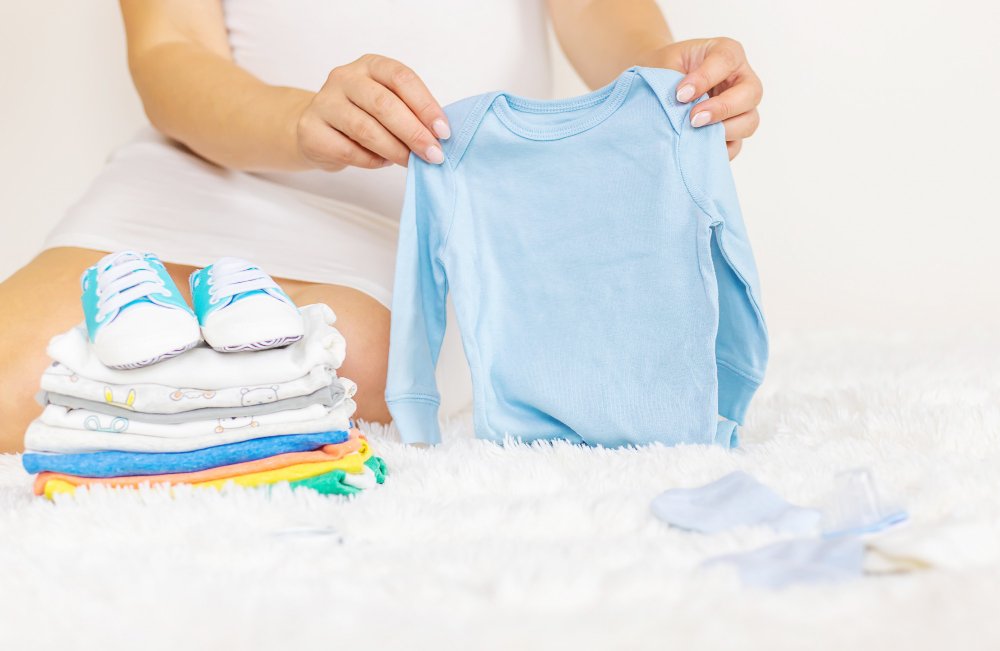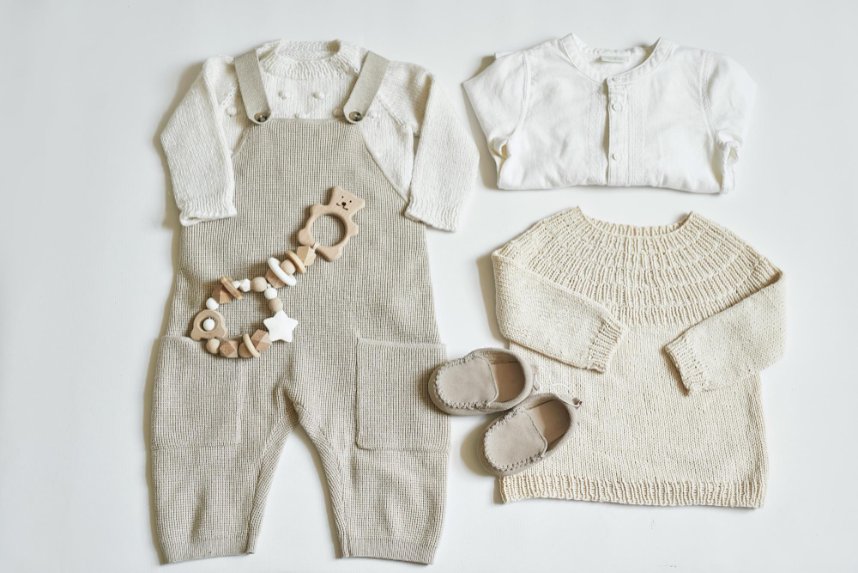Your Complete Guide to Safe, Smart, and Sustainable Baby Hand-Me-Downs
Quick Summary: Hand-me-downs are a smart way to save money and help the environment when you have a baby. The best time to reuse baby clothes is when they’re clean, undamaged, and meet current safety standards. This guide will show you exactly what to look for, how to clean items safely, and which hand-me-downs to avoid.
Helpful Tools: Use our Hand-Me-Down Cost Savings Calculator to see how much money you can save, check our Safety Checklist Tool to ensure items are safe, and try our Age-Appropriate Generator to find suitable items for your child’s developmental stage.
Table of Contents
- What Are Hand-Me-Down Clothes?
- Why Hand-Me-Downs Are Good for Families
- Hand-Me-Down Savings Calculator
- How to Evaluate Baby Items for Safe Reuse
- Complete Cleaning and Care Guide
- What Items Are Safe to Reuse
- Items You Should Never Accept as Hand-Me-Downs
- How to Store Baby Clothes for Future Use
- What to Do with Unwanted Hand-Me-Downs
- Frequently Asked Questions
What Are Hand-Me-Down Clothes?
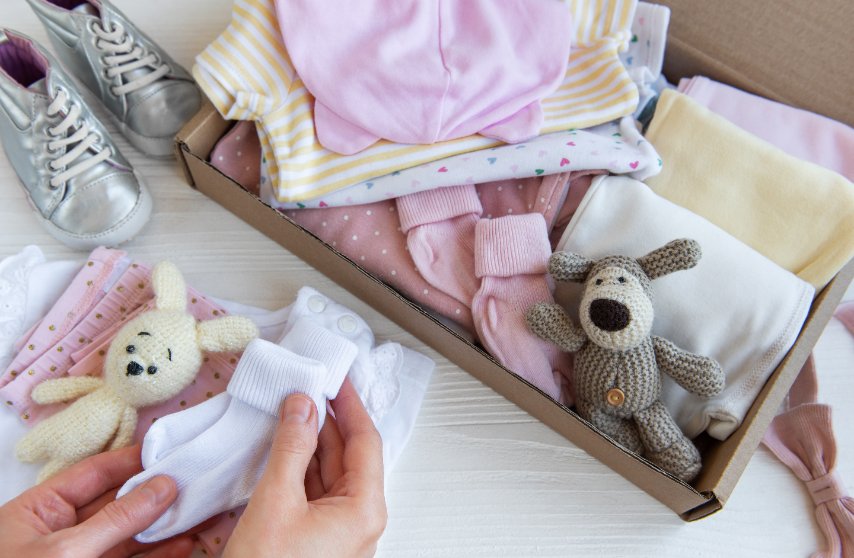
Hand-me-down clothes are previously owned clothing items passed from one person to another, usually within families or between friends. For babies and children, this tradition makes perfect sense because kids grow so quickly that clothes often remain in excellent condition when they’re outgrown.
The term “hand-me-down” comes from the practice of older siblings literally handing down their outgrown clothes to younger ones. Today, this concept has expanded to include items shared between families, sold at consignment shops, or donated to those in need.
Did you know? Hand-me-down beliefs vary by culture, but most families around the world practice some form of clothing sharing. It’s seen as both practical and a way to maintain family connections through shared items.
Why Hand-Me-Downs Are Good for Families
Average savings on first-year clothing costs
Typical amount saved per child using hand-me-downs
Less textile waste when clothes are reused
Financial Benefits
Raising a child costs families significant money each year, with clothing being a major expense. Hand-me-downs can reduce these costs dramatically, especially during the first few years when children grow rapidly.
When families accept quality second-hand baby clothes, they can redirect money toward other important needs like healthcare, education, or creating an emergency fund. Our interactive cost savings calculator can show you exactly how much you could save each year by using hand-me-downs.
Environmental Advantages
Each reused item means one less new product manufactured, which reduces resource consumption and waste. According to the Environmental Protection Agency (EPA), 11.3 million tons of textiles ended up in landfills in 2018, representing 7.7% of all municipal solid waste.
Is buying second-hand clothes more sustainable? Yes, absolutely. Reusing clothes is one of the most sustainable things you can do with clothing because it prevents items from ending up in landfills while reducing demand for new production.
Building Family Connections
Hand-me-downs create emotional connections between generations. When a child wears the same outfit their older sibling or cousin wore, it creates shared family stories and memories that new items simply cannot match.
Hand-Me-Down Savings Calculator
Calculate Your Potential Savings
Use this calculator to see how much you could save with hand-me-downs:
How to Evaluate Baby Items for Safe Reuse
Check for stains, tears, worn areas, and fading
Examine fasteners, buttons, zippers, and potential choking hazards
Ensure items meet current safety standards (check manufacturing dates)
Verify the item hasn’t been recalled by checking CPSC database
Wash thoroughly before use
Condition Assessment for Baby Garments
Start by examining each item in bright light. Look for rips, weak seams, or stretched-out elastic that might affect comfort or safety. Check that all snaps, buttons, and zippers work properly, as broken fasteners can be frustrating and potentially dangerous.
For a comprehensive safety inspection, use our detailed baby hand-me-down safety checklist to ensure you don’t miss any important safety checks.
Pay special attention to fabric wear. Thin spots might tear soon after reuse. Test the strength by gently pulling the material in different directions. While minor stains don’t necessarily make clothes unusable, deeply set stains from mold or unknown substances warrant disposal.
Safety Red Flags to Watch For
- Drawstrings on clothing (strangulation hazard)
- Loose buttons or small parts that could be choking hazards
- Worn elastic that no longer provides proper fit
- Fabric that feels rough or stiff (may contain harmful chemicals)
- Items with strong chemical odors
- Clothing with damage near seams or safety features
Complete Cleaning and Care Guide
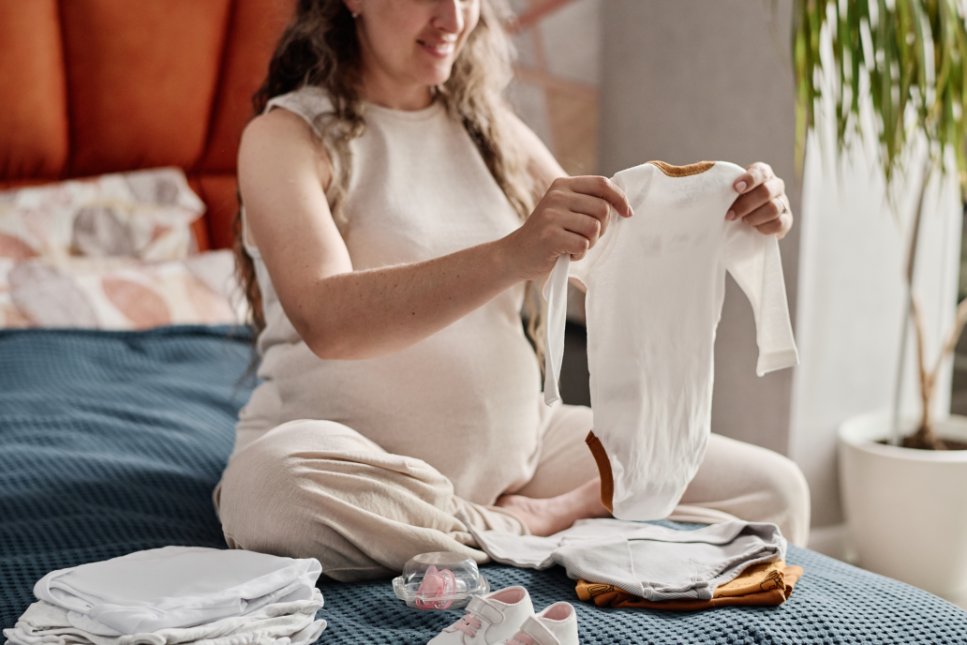
Do I Need to Wash Hand-Me-Down Baby Clothes?
Yes, you should always wash hand-me-down baby clothes before use. This removes potential allergens, bacteria, and any residue from previous cleaning products or storage conditions.
How to Clean Different Types of Hand-Me-Downs
| Item Type | Cleaning Method | Special Considerations |
|---|---|---|
| Cotton Clothes | Machine wash warm, tumble dry | Check for proper cotton care techniques |
| Delicate Fabrics | Hand wash or gentle cycle | Air dry to prevent shrinkage |
| Plastic Toys | Soap and water, then disinfect | Use 1 tbsp bleach per gallon water solution |
| Stuffed Animals | Machine wash in pillowcase | Check if machine washable first |
| Books | Wipe with disinfectant wipes | Focus on board books for babies |
Best Practices for Washing Hand-Me-Downs
Should you wash hand-me-down baby clothes? Absolutely. Here’s the recommended process:
- Sort by fabric type and color – Different fabrics require different care methods
- Pre-treat any visible stains – Use a mixture of baking soda and water for tough spots
- Wash twice if heavily soiled – First wash removes surface dirt, second ensures deep cleaning
- Use baby-safe detergent – Choose products free from harsh chemicals and fragrances
- Dry thoroughly – Ensure complete drying to prevent mold and mildew
When Can You Stop Washing Baby Clothes Before Wearing?
You should continue washing new and hand-me-down clothes before use throughout your child’s infancy and toddler years. Washing toddler clothes before use remains important until their immune systems are more developed, typically around age 2-3.
Natural Cleaning Solutions
Is vinegar safe to use on baby clothes? Yes, white vinegar is a natural disinfectant and fabric softener that’s safe for baby clothes. Add 1/2 cup to the rinse cycle to eliminate odors and bacteria naturally.
How to Make Baby Clothes Smell Good Naturally
- Add 1/4 cup baking soda to the wash cycle
- Use wool dryer balls instead of fabric softener sheets
- Line dry in fresh air and sunlight when possible
- Store clean clothes with natural sachets (lavender or cedar)
What Items Are Safe to Reuse
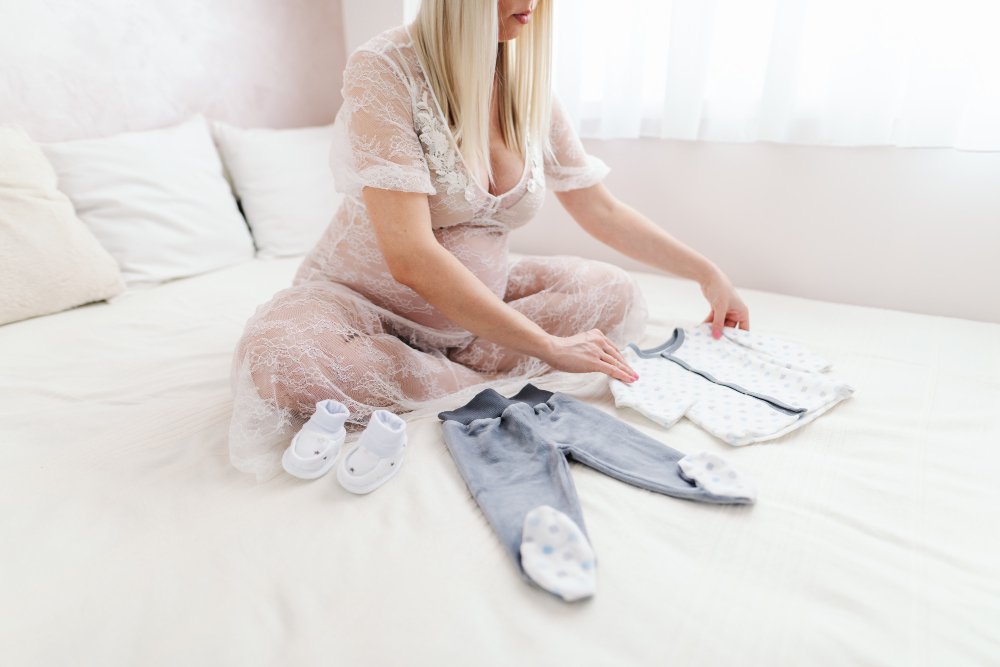
Clothing That’s Perfect for Hand-Me-Downs
Is it okay to use used baby clothes? Yes, most clothing items are safe to reuse when properly cleaned and inspected. The best candidates include:
Before accepting any hand-me-downs, consider your child’s age and developmental stage. Our age-appropriate hand-me-down generator can help you determine which items are suitable for your child’s current needs.
- Basic everyday items – Onesies, sleepers, and play clothes that see regular use but remain in good condition
- Special occasion wear – Dressy outfits and formal wear that are rarely worn and often remain like new
- Seasonal clothing – Seasonal infant wear that may only be worn for a few months
- Outerwear – Coats and jackets that typically last longer than everyday clothes
Toys and Books
Gently used toys are generally safe to accept as hand-me-downs. Inspect all toys for loose parts, sharp edges, or chipped paint. Books, especially board books, make excellent hand-me-downs after proper cleaning.
Bath Items
Baby bathtubs can be reused safely when thoroughly cleaned and inspected for cracks or damage. Avoid any tubs with visible mold, defects, or sharp edges.
Cloth Diapers
While it may seem unusual, cloth diapers can be safely passed down between children. Like other clothing, they often have limited use before being outgrown and can be thoroughly sanitized.
Items You Should Never Accept as Hand-Me-Downs
Never Reuse These Items
Car Seats
Car seats should never be accepted as hand-me-downs. They expire 6-10 years from manufacture and can be compromised by accidents, even when damage isn’t visible. The safety of your child depends on having a car seat with a known history.
Crib Mattresses
Used mattresses can harbor allergens, mold, and bacteria that aren’t visible. They may also have indentations that affect safe sleep positioning. Always buy crib mattresses new.
Breast Pumps
Personal-use breast pumps should not be shared between mothers due to contamination risks. Only hospital-grade pumps designed for multiple users can be safely shared with new accessory kits.
Bottle Nipples and Pacifiers
These items can harbor bacteria in tiny cracks and should be replaced regularly. Even small tears can trap germs that pose health risks.
Helmets
Any safety helmet (bike, sports, etc.) should never be reused as it may have structural damage from previous impacts.
When to Avoid Clothing Hand-Me-Downs
Some clothing items should be avoided:
- Items with drawstrings – Especially around the neck area, as these pose strangulation risks
- Severely stained clothing – Stains may indicate exposure to harmful substances
- Clothes with worn elastic – These won’t fit properly and may be uncomfortable
- Flame-retardant items that feel stiff – Older flame-retardant treatments may contain harmful chemicals
Why Do Some Baby Clothes Say “Keep Away from Fire”?
You might wonder why Zara baby clothes say “keep away from fire” or why baby pajamas have specific warnings. This labeling is required by law for children’s sleepwear that doesn’t meet tight-fitting standards or contain flame-retardant materials. Children’s flame-retardant clothing standards ensure safety, but parents should always keep children away from heat sources regardless of clothing type.
How to Store Baby Clothes for Future Use
Preparing Clothes for Storage
How to preserve baby clothes for years requires proper preparation:
- Clean thoroughly – Remove all stains and odors before storage
- Ensure complete drying – Any moisture can lead to mold and mildew
- Sort by size and season – This makes retrieval easier later
- Use acid-free boxes or containers – These prevent yellowing and deterioration
Best Storage Methods
How to store new clothes long term and preserve them for future children:
- Vacuum-sealed bags – Save space but may cause wrinkles
- Clear plastic bins with tight lids – Allow easy identification while protecting from moisture
- Cedar chests – Natural moth repellent but ensure items are completely clean first
- Climate-controlled storage – Ideal for long-term preservation
How Long Are Baby Clothes Good For?
Properly stored baby clothes can last 10-20 years or more. Cotton and natural fibers tend to last longer than synthetic materials. The key is keeping them clean, dry, and protected from pests.
Getting Yellow Stains Out of Stored Baby Clothes
How to get yellow stains out of baby clothes that have been stored:
- Soak in cold water with oxygen bleach for 24 hours
- Make a paste with baking soda and water, apply to stains
- Use lemon juice and salt for natural bleaching
- Hang in direct sunlight after treatment
What to Do with Unwanted Hand-Me-Downs
What to Do with Hand-Me-Down Baby Clothes You Don’t Want
Not every hand-me-down will work for your family. Here are responsible ways to handle unwanted items:
Donation Options
- Local shelters and churches – These organizations often help families in need
- Women’s shelters – Specifically help mothers with young children
- Homeless shelters – Always in need of children’s clothing
- Daycare centers – May use extra clothes for accidents and emergencies
Selling Options
If items are in excellent condition, consider selling through:
- Online marketplaces like Poshmark or eBay
- Apps like Depop or Vinted for younger demographics
- Local consignment shops
- Facebook marketplace or local buy/sell groups
What to Do with Worn Out Baby Clothes
For clothes too damaged to donate or sell:
- Repurpose as cleaning rags – Baby clothes make excellent soft cleaning cloths
- Craft projects – Use fabric for quilts, memory books, or stuffed animals
- Textile recycling – Many communities have textile recycling programs
- Compost natural fibers – 100% cotton items can be composted after removing hardware
How to Decline Hand-Me-Downs Politely
Sometimes you need to decline offered hand-me-downs. Here’s how to do it gracefully:
- “Thank you so much for thinking of us. We’re pretty set on clothes right now.”
- “I appreciate the offer, but we’re trying to minimize what we bring into the house.”
- “That’s so kind of you. Could I connect you with [another family] who might need them?”
Frequently Asked Questions
Yes, always wash hand-me-down baby clothes before your child wears them. This removes potential allergens, bacteria, and any residue from previous cleaning products or storage conditions. Use a gentle, baby-safe detergent and wash items twice if they seem heavily soiled. For a complete safety inspection before washing, use our comprehensive safety checklist.
Most pediatricians recommend using baby-specific detergent until your child is at least 12-18 months old. After this age, you can gradually transition to regular detergent if your child doesn’t have sensitive skin or allergies. Learn more about when to switch to regular detergent for detailed guidelines.
Keep what you realistically need based on your laundry schedule. For newborns, aim for 7-10 onesies, 5-7 sleepers, and 3-5 outfits per size. Remember that babies grow quickly, so don’t over-accumulate any single size. Focus on versatile, mix-and-match pieces rather than complete outfits.
Used cribs can be safe if they meet current safety standards and are in excellent condition. Never use cribs older than 10 years or those made before 2011, as they don’t meet current safety regulations. Check that slats are no more than 2⅜ inches apart, and verify the crib hasn’t been recalled on the American Academy of Pediatrics safe sleep guidelines. Always get a new mattress regardless of crib condition.
Yes, many newborns can wear 0-3 month clothes, especially if they weigh over 7 pounds at birth. However, having some newborn sizes on hand is wise since babies vary greatly in size. Understanding the differences between infant and newborn sizes can help you prepare appropriately.
Glass bottles can potentially be reused if they’re in perfect condition with no chips or cracks. However, plastic bottles should not be shared between families due to concerns about bacteria harboring in scratches and potential chemical breakdown over time. Bottle nipples should always be purchased new, as they can harbor bacteria in tiny cracks.
Newborns typically need 2-3 outfit changes per day due to spit-up, diaper leaks, and feeding accidents. As babies get older and these incidents decrease, you might only need 1-2 changes daily. Always change clothes immediately if they become soiled, regardless of how recently they were changed.
Regular chlorine bleach is too harsh for baby clothes and can irritate sensitive skin. Instead, use oxygen bleach (color-safe bleach) which is gentler and still effective at removing stains and bacteria. Always rinse thoroughly after using any bleaching agent.
Sizes 6-12 months and 12-18 months typically last the longest because babies’ growth rate slows down after the rapid growth of the first 6 months. Newborn and 0-3 month sizes are outgrown very quickly, sometimes within just a few weeks.
For shipping hand-me-downs to family or friends, use USPS Priority Mail flat-rate boxes for heavy items, or regular ground shipping for lighter packages. Vacuum-sealing clothes can reduce shipping costs by minimizing package size. Consider splitting large quantities into multiple smaller packages if it results in lower total shipping costs.
Additional Considerations for Hand-Me-Downs
The Rule of Clothes for Babies
What is the rule of clothes for babies? The general rule is to dress babies in one more layer than you’re comfortable wearing, plus always have backup outfits available. For hand-me-downs, ensure you have enough clothes for at least 3-4 days between laundry loads, accounting for multiple daily changes.
Understanding Baby Clothing Safety Standards
Why do baby pajamas have to be tight? Loose-fitting sleepwear poses a fire hazard because it can catch fire more easily and burn more rapidly. Tight-fitting sleepwear is designed to self-extinguish and reduce fire risk. This is why you’ll see warnings on looser pajamas and why flame-retardant treatments are used on some children’s clothing.
The yellow tag on baby pajamas indicates the garment meets federal flammability standards. When accepting hand-me-down sleepwear, ensure tags are still attached and readable to verify safety compliance.
When Hand-Me-Downs Become Gifts
Is a hand-me-down a gift? This depends on the relationship and how items are presented. When offered thoughtfully by close family or friends, hand-me-downs can indeed be meaningful gifts. However, it’s important to ask before giving hand-me-downs and present them in a way that feels generous rather than like you’re disposing of unwanted items.
Fabric Care for Different Materials
Different fabrics require specific care approaches:
- Cotton items – Follow cotton care guidelines for best results
- Wool clothing – Reference our wool care guide for proper handling
- Synthetic fabrics – Check our guide on caring for synthetic fabrics
- Delicate items – Silk and other delicate fabrics need special attention
Conclusion
Hand-me-downs represent one of the smartest approaches to managing the costs and environmental impact of raising children. When done safely and thoughtfully, accepting and passing along baby items creates a cycle of sustainability that benefits families and the planet.
Key Takeaways for Safe Hand-Me-Down Use
- Always prioritize safety – Never accept items like car seats, crib mattresses, or expired safety equipment
- Clean everything thoroughly – Wash all clothing and sanitize toys and equipment before use
- Inspect carefully – Check for damage, wear, recalls, and age-related safety concerns
- Know what to avoid – Steer clear of items with drawstrings, excessive wear, or unknown histories
- Store properly – When saving items for future children, clean and store them correctly to maintain quality
Financial and Environmental Impact
Families who thoughtfully incorporate hand-me-downs into their approach can save 60-80% on clothing costs during their child’s first few years. This translates to hundreds or even thousands of dollars that can be redirected toward other important needs like healthcare, education, or building financial security.
From an environmental perspective, extending the life of baby clothes and equipment through reuse significantly reduces textile waste and manufacturing demand. Each item that gets a second life represents resources saved and waste prevented.
Building Community Through Sharing
Hand-me-downs also foster community connections between families. Whether sharing between siblings, cousins, friends, or neighbors, these exchanges create relationships and support networks that benefit everyone involved. The tradition of passing along outgrown items connects generations and teaches children about sharing and sustainability from an early age.
Final Recommendations
As you navigate the world of baby hand-me-downs, remember that your child’s safety and your family’s comfort should always come first. Don’t feel obligated to accept every offer, and don’t hesitate to politely decline items that don’t meet your standards or needs.
To make the most of hand-me-downs, use our helpful tools: calculate potential savings with our cost calculator, ensure safety with our comprehensive safety checklist, and find age-appropriate items using our recommendation generator.
When offering hand-me-downs to others, present them thoughtfully – clean, organized, and with honesty about any limitations or issues. This consideration helps maintain positive relationships and ensures the items will be genuinely useful to the receiving family.
Most importantly, view hand-me-downs as one tool in your parenting toolkit rather than the complete solution. Combining carefully selected hand-me-downs with strategic new purchases creates the best approach for keeping your child safe, comfortable, and well-dressed while managing your budget and environmental impact responsibly.
Remember: Every family’s situation is different. Trust your instincts about what works for your child and your circumstances. Hand-me-downs should make parenting easier and more affordable, not create stress or compromise safety.

